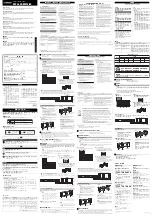
TFP1100
Page 4 of 16
Notes:
1.
Quick operation of the Electronic Accelerator does not ensure that the fire protection system will meet the water
delivery time requirement of the authority having jurisdiction (following opening of the Inspector’s Test Connection).
The sprinkler system designer has to be aware that water delivery time is primarily determined by the configuration
and volume of the piping network, system air pressure at time of Accelerator trip, number and orifice size of open
sprinklers, and water supply characteristics.
2.
The sensitivity criteria for the Model QRS Electronic Accelerator is a function of its pressure decay for trip rating of
0.1 psi (0,007bar) per second, as well as the system volume, the K-factor of the sprinklers being utilized, and the
minimum initial air pressure. The larger the system volume combined with smaller sprinkler K-factor or lower initial
air pressure results in a slower air decay rate upon the first sprinkler operation. Conversely, a smaller system vol-
ume combined with a larger sprinkler K-factor or higher initial air pressure results in a faster air decay rate.
3.
When the sprinkler system has been designed with in the criteria provided by Graph A, operation of the Model QRS
Electronic Accelerator and subsequent operation of the associated dry pipe or preaction valve can be expected
within four seconds. In the case of the double interlock preaction system, operation is based on the electric detec-
tion system operating before a first sprinkler operation.
4.
The minimum system air pressure must be the greater of that required for the dry pipe / preaction valve as a
function of the maximum expected water supply pressure or per Graph A when using the Model QRS Electronic
Accelerator.
5.
When multiple sprinkler operations are being considered as in the case of using a dry system water delivery design
per the 2002 edition of NFPA 13, Section 11.2.3.9, use the “11.2 K-factor and larger” curve as referenced in Exam-
ple 3.
Examples:
1.
Assuming a system volume of 1500 gal (5680 L) and the use of sprinklers having a K-factor of 5.6, the minimum
system air pressure must be 18.5 psi (1,3 bar).
2.
Assuming a system volume of 2000 gal (7570 L) and the use of sprinklers having a K-factor of 8.0, the minimum
system air pressure must be 16.0 psi (1,1 bar).
3.
Assuming the use of a dry system water delivery design per the 2007 edition of NFPA 13, Section 7.2.3.6, where in
the operation of two 5.6 K-factor sprinklers might be anticipated (and the effective K-factor is then 11.2), the “11.2
K-factor and larger” curve can be utilized. Consequently, assuming a system volume of 2400 gal (9084 L), the mini-
mum system air pressure must be 11.5 psi (0,8 bar).
10
20
30
40
50
60
MINIMUM SYSTEM AIR PRESSURE, PSI (BAR)
K=4.2
K=5.6
K=8.0
K≥
11.2
(0,7)
(1,4)
(2,1)
(2,8)
(3,4)
(4,1)
MAXIMUM SYSTEM CAP
ACITY
,
GALLONS (LITRES)
800 (3028)
1000 (3785)
1200 (4542)
1400 (5299)
1600 (6056)
1800 (6813)
2000 (7570)
2200 (8327)
2400 (9084)
2600 (9841)
2800 (10598)
GRAPH A
MODEL QRS ELECTRONIC ACCELERATOR
SENSITIVITY CRITERIA BASED ON FM APPROVAL


































